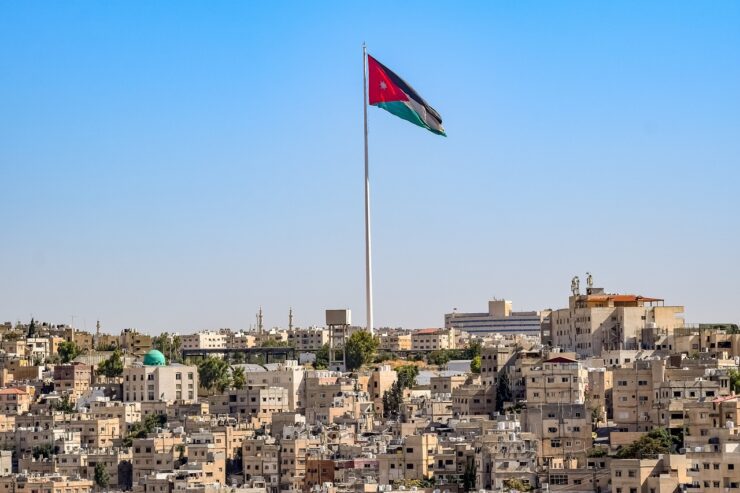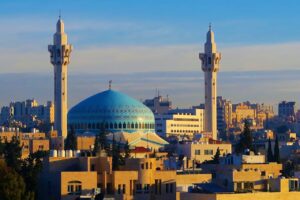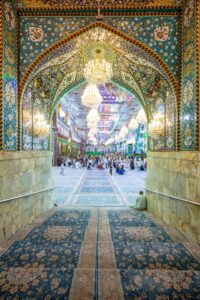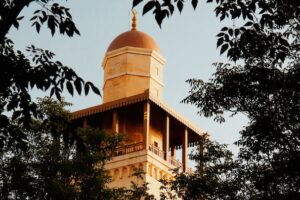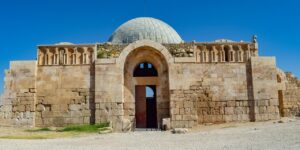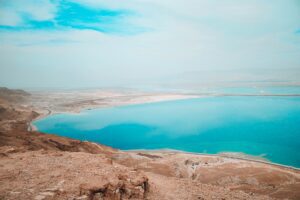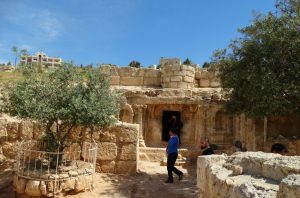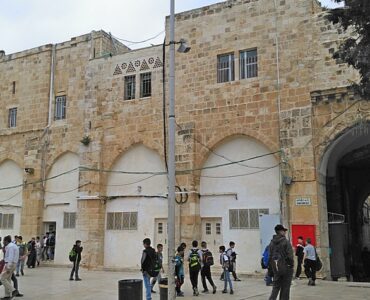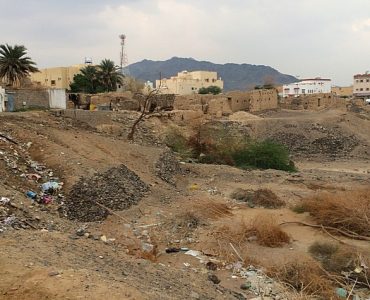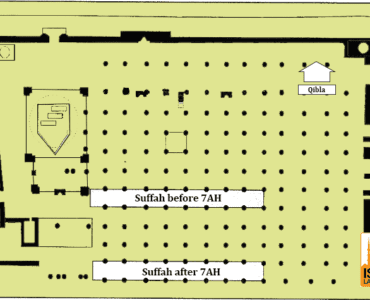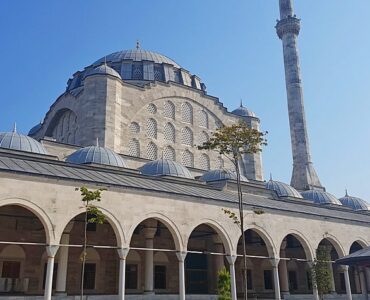Jordan, a land steeped in ancient Christian and Islamic traditions, holds a special place in the hearts of Muslims worldwide.
Jordanian architectural heritage includes a multitude of mosques that not only reflect the country’s beauty but also stand as a symbol of its deep-rooted connection to Islam.
With their stunning architecture and peaceful ambience, the mosques of Jordan provide both locals and visitors with a place for prayer, contemplation, and connection to the city’s history and spiritual essence.
Continue reading to learn about the beautiful mosques in Jordan.
How Many Mosques in Jordan?
According to the Minister of Awqaf and Islamic Affairs, there are approximately 7600 mosques in Jordan.
These include Abu Darweesh Mosque, Ali bin Abi Talib Mosque, King Abdullah I Mosque, King Hussein Mosque, Prophet Shuaib Shrine, Prophet Jadur Shrine, and Nabi Harun Shrine.
However, a 2017 Jordan Times article stated that out of the 6000 mosques in Jordan, 3000 don’t have officially assigned imams. Another article from 2020 reported that 1284 of the 7100 mosques are without imams.
Famous Mosques in Jordan
The country of Jordan is home to some of the most popular Islamic landmarks in the world, including King Abdullah I Mosque, King Hussein Mosque, Abu Darweesh Mosque, Prophet Jadur Shrine, and Nabi Harun Shrine.
The Most Famous Mosque in Jordan: King Abdullah 1 Mosque
King Abdullah I Mosque is the most famous Masjid in Jordan. Completed in 1989 as a memorial by the late King Hussein to his grandfather, King Abdullah I Mosque is the largest Masjid in the state.
King Abdullah I Mosque is known for its beautiful architecture and distinctive blue dome that can be seen from afar.
The mosque’s octagonal courtyard can accommodate over 3000 worshippers, and the hall can provide space for 7000 people.
King Abdullah 1 Mosque has a small women’s section and private royal enclosure, accommodating up to 200 – 300 people.
In addition to the vast blue dome, the walls of King Abdullah 1 Mosque are decorated with Quranic inscriptions.
King Abdullah 1 Mosque is the only Masjid in Amaan where non-Muslims are allowed.
Other features of King Abdullah 1 Mosque are a library with 20,000 books, a reception area, Dar al-Quran, roofed lounges and halls, an Islamic museum, and a charity market.
If you want to visit a Jordan museum, this is the place to go!
What Can You Wear to the King Abdullah Mosque?
When visiting King Abdullah 1 Mosque, it is important to dress modestly and respectfully. If you are a man, wear long trousers or pants and a shirt that covers your shoulders.
However, women are advised to wear either a full-length dress or loose clothing that covers their bodies.
Wearing long pants and sleeves is essential, and any revealing dress is strictly prohibited.
Women must also wear a headscarf before entering King Abdullah 1 Mosque.
Biggest Mosque in Jordan
King Hussein Bin Talal Mosque is the largest Masjid in Jordan. Also known as King Hussein Mosque, the Masjid covers 60,000 square metres of area and can accommodate up to 5500 worshippers.
The square-shaped mosque features marble floors and four minarets.
King Hussein Bin Talal Mosque’s structure perfectly combines classic and modern architecture, making it the perfect place for halal travel..
Name of the Biggest Mosque in Jordan
The name of the biggest mosque in Jordan is King Hussein Bin Talal Mosque.
King Hussein Mosque is located at King Abdullah II Street in Al Hussein Public Parks near King Hussein Medical Centre.
Oldest Mosque in Jordan
In this section, we will discuss some of the oldest mosques in the history of Jordan that you can discover as you travel through the beautiful country.
Ali bin Abi Talib Mosque
Developed in Irbid, Jordan, Ali bin Abi Talib Mosque was originally built during the Ottoman Empire era and then renovated and expanded in 1998.
Named after the son-in-law of Prophet Muhammad (PBUH), Ali bin Abi Talib Mosque is a place of profound significance for millions of Muslims worldwide.
Ali bin Abi Talib Mosque has a simple architectural design and features one minaret and a grand dome.
The Grand Hussein Mosque
Constructed over 80 years ago, the Grand Hussein Mosque is the oldest Masjid in Amman.
This mosque was one of Jordan’s kingdom’s biggest architectural projects.
According to the religious committee members, the Grand Hussein Mosque is one of the highly visited Amman attractions and receives approximately 1500 worshippers for Zuhr prayer
Thousands of people travel to the mosqye every year to marvel at its grandeur.
However, for senior citizens, visiting the Grand Hussein Mosque is a trip down memory lane.
The Grand Hussein Mosque has a domed fountain, a prayer hall, a courtyard, and walls decorated with Quranic verses.
The Grand Hussein Mosque currently covers 2000 square metres of land and can accommodate 2600 worshippers.
Mosques in Amman
Amman, the capital city of Jordan, is home to various beautiful and historically significant mosques and the perfect place to travel.
These mosques reflect the rich cultural and religious diversity of the region.
How Many Mosques in Amman?
The exact number of mosques in Amman is not known. However, three popular masjids in Amman are King Abdullah 1 Mosque, Ali bin Abi Talib Mosque, and King Hussein Bin Talal Mosque.
King Hussein Mosque
One of the oldest mosques in Amman, King Hussein Mosque, was re-constructed by King Abdullah 1 in 1932 on the exact site of the one built by Umar (AS) during his Caliphate in 640 AD.
The Ottoman-style mosque is located at an altitude of 1013 metres (3323 feet/ 0.62 miles) above sea level.
King Hussein Bin Talal Mosque has a capacity of 5500 worshippers, marble floors, one large centred dome and four minarets.
The mosque has a fort-like architecture and can be seen from afar.
Abu Darweesh Mosque
Featuring striking and distinctive black and white stone architecture, Abu Darweesh Mosque is situated on the top of Jebel al-Ashrafiyeh, the highest hill in Amman, Jordan.
Abu Darweesh Mosque was built in 1961 with financial support from Abu Darweesh (also called Hasan Mustafa Sharkas. Abu Darweesh Mosque covers roughly 2500 square metres of land.
Inside the mosque, the intricate calligraphy and delicate patterns that adorn the walls are a testament to the craftsmanship of local artisans.
Other Historic Islamic Places in Jordan
Want to learn more about the historical monuments in Jordan before you travel? In this section, we will be discussing three of Jordan’s most famous and significant religious sites.
Umayyad Palace
Umayyad Palace is located on Jabal al-Qal’a (Citadel Hill) of Amman, Jordan. The Umayyad Palace was constructed in the first half of the 8th century and used to be the residence of the governors during the Umayyad Dynasty.
The palace comprises three areas; a large area for people to gather, a well-decorated and preserved audience hall, and nine independent buildings that represent the destroyed part of the palace.
Today, the Umayyad Palace features a restored domed entrance chamber called the “monumental gateway” or “kiosk.”
The stucco ornaments and geometric designs make Umayyad Palace’s architecture stand out from other regional palaces.
Dead Sea
Situated between Jordan, West Bank, and Israel, the Dead Sea is a saltwater lake. Known for its extremely high salt concentration, the Dead Sea is the lowest point in the world, about 1412 feet (400 metres/0.26 miles) below typical sea level.
According to Islamic history, the Dead Sea is a reminder of Allah SWT’s punishment of the wicked evildoers and ignorant people of Sodom city, the Ummah of Prophet Lut (AS).
The Prophet of Allah SWT preached the message of God in every way possible. Despite his endless tries, even Prophet Lut’s (AS) wife didn’t convert. As a result, Allah SWT destroyed the city.
“Turn the cities upside down, and rain down on them brimstones hard as baked clay, spread layer on layer, marked from your Lord.” [Holy Quran 11:82–83]
Prophet Muhammad (PBUH) strictly advised people from visiting a place of God’s punishment, such as the Dead Sea. He said,
“Do not enter the place of those who were unjust to themselves unless you are weeping, lest you should suffer the same punishment as was inflicted upon them.”
However, if you get a chance to travel to the Dead Sea, use the time to remember the story of Prophet Lut (AS) and how he fought for Islam. Allah SWT in the Holy Quran says,
“Surely! In this are signs for those who understand. And verily, they [the cities] are right on the high road. Surely! Therein is indeed a sign for the believers.” [Holy Quran 15:75–77]
“And to Lut, too, We gave wisdom and knowledge; We saved him from the town which practised abominations. Truly they were a people given to evil, a rebellious people. And We admitted him to Our mercy; for he was one of the righteous.” [Holy Quran 21:74–75]
Cave of Ashabe-Kahf
The cave of Ashabe-Kafh is located in the suburb of Abu Alanda, Amman, Jordan.
According to Islamic and Christian tradition, this is the same cave where six believers and one of their dogs found refuge after escaping the persecutions of the cruel Roman king.
Allah SWT in the Holy Quran states, “[Some] say, ‘The sleepers were three, and their dog made four,’ others say, ’They were five, and the dog made six’- guessing in the dark – and some say,’ They were seven, and their dog made eight.’ Say [Prophet], ‘My Lord knows best how many they were.’ Only a few have real knowledge about them, so do not argue, but stick to what is clear, and do not ask any of these people about them.” [Holy Quran 18:22]
The seven slept for over 300 years and miraculously woke up like no time had passed away.
It is said that these people eventually died in 550 AD after sharing the story with the world. Later, the seven were buried inside the Cave of Ashabe-Kahf.
Tomb of Aaron
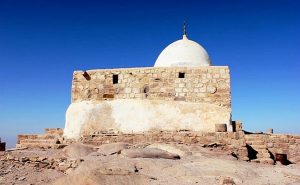

Located in Petra, Jordan, the Tomb of Aaron was constructed in the Mamluk era in the early 14th century and comprised a small courtyard and a room.
The prayer hall of the white-domed mosque is on the ground floor.
Summary – Mosques in Jordan
A country in the middle east with diverse cultural heritage and rich history, Jordan offers unique excursions to visitors worldwide.
From the majestic beauty of King Abdullah I Mosque in Amman and King Hussein Bin Talal Mosque to the historical significance of the Cave of Ashabe-Kahf and Umayyad Palace, every religious site tells a tale of Jordan’s intricate past and its blend of traditions.
Exploring the mosques in Jordan gives you a chance to witness the coexistence of the ancient and modern while instilling peace in your heart and soul.
Remember to stay modest and respectful as you travel through these historic landmarks

